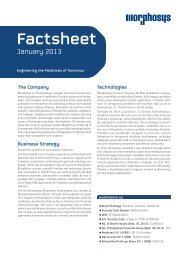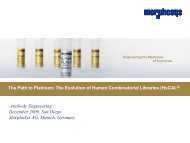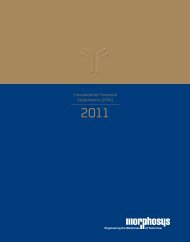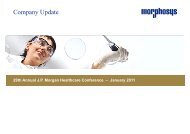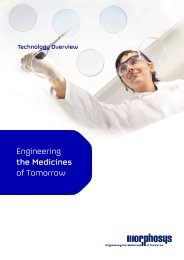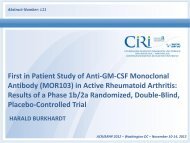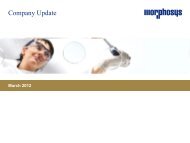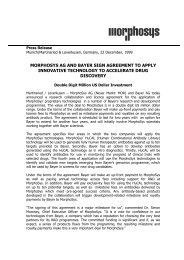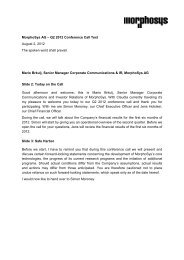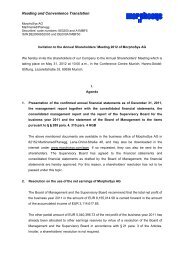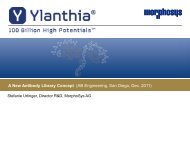Study Design Streptococcal Cell Wall Induced Arthritis - MorphoSys
Study Design Streptococcal Cell Wall Induced Arthritis - MorphoSys
Study Design Streptococcal Cell Wall Induced Arthritis - MorphoSys
Create successful ePaper yourself
Turn your PDF publications into a flip-book with our unique Google optimized e-Paper software.
Development of a HuCAL GOLD ® human monoclonal<br />
antibody for the therapeutic treatment of inflammatory diseases<br />
Human Antibodies & Hybridomas, New York, November 12 th -14 th , 2008
Contents<br />
2<br />
� Introduction<br />
� MOR103 anti-GM-CSF antibody program<br />
� GM-CSF target physiology<br />
� MOR103 antibody discovery and development<br />
� Generation<br />
� Selection<br />
� Efficacy<br />
� Safety, Tolerability and Pharmacokinetics<br />
� MOR103 antibody manufacture<br />
� PER.C6 ® human cell line<br />
� Drug product formulation<br />
� MOR103 antibody clinical trial<br />
� Phase 1/First in Man<br />
� Conclusion<br />
HAH, New York, Nov 2008 | © <strong>MorphoSys</strong> AG
Introduction<br />
� MOR103: human monoclonal IgG1 targeting GM-CSF*<br />
� GM-CSF: proinflammatory cytokine functions<br />
� Initial indication: Rheumatoid <strong>Arthritis</strong> (RA)<br />
3<br />
� RA patients adequately treated
GM-CSF Target Physiology<br />
� Structure and Activity<br />
4<br />
� Glycoprotein: MW≈15kDa<br />
� RA synovial fluid concentration
MOR103 Antibody Selection*<br />
5<br />
H-CDR2<br />
Maturation<br />
Pre-Built Trinucleotide Cassettes<br />
HCDR1<br />
HCDR2<br />
HCDR3 LCDR1 LCDR2 LCDR3<br />
HuCAL VH HuCAL VL<br />
Unique Fab panel<br />
Selection of parental Fabs<br />
Pannings & Screening<br />
Antibody Characterization<br />
H-CDR2-optimized Fabs L-CDR3-optimized Fabs<br />
CDR Cross-Cloning<br />
Affinity optimized lead monoclonal antibodies<br />
L-CDR3<br />
Maturation<br />
*Urban, M (2007) HAH<br />
Steidl et al. (2008) MIMM 46: 135-144<br />
HAH, New York, Nov 2008 | © <strong>MorphoSys</strong> AG
MOR103 Antibody Characteristics<br />
6<br />
<strong>Study</strong> MOR103 Antibody<br />
Affinity<br />
(Fab SET)<br />
Inhibits<br />
� Human and rat GM-CSF (K D=0.4pM and 1100pM)<br />
� Binding of GM-CSF to GM-CSFR-α<br />
� TF-1 and FDCP-1 cell proliferation<br />
� GM-CSF induced PMN migration, CD11b expression<br />
and MHC class II up-regulation<br />
� GM-CSF mediated PMN Stat-5 phosphorylation*<br />
SET, solution equilibrium titration<br />
K D, dissociation constant<br />
TF-1, Human erythroleukemic cells<br />
FDCP, Factor dependent cell Paterson (murine bone cells)<br />
PMN, polymorphonuclear neutrophil<br />
Stat-5, Signal Transducer Activator of Transcription-5<br />
* w. GM-CSF<br />
* w/o. GM-CSF<br />
* w. GM-CSF and MOR103<br />
HAH, New York, Nov 2008 | © <strong>MorphoSys</strong> AG
MOR103 Antibody Cross Reactivity<br />
7<br />
<strong>Study</strong> MOR103 Antibody<br />
Cross<br />
Reactivity<br />
� Specific to human GM-CSF cf. IL-3, IL-4, IL-5 & M-CSF<br />
� Neutralises rat a (IC 50=35nM) GM-CSF<br />
� Neutralises human b and rhesus b GM-CSF (IC 50 = 11pM to 48pM)<br />
� No non-specific human or rhesus tissue binding<br />
a FDCP-1 or b TF-1 cell proliferation assays<br />
FDCP, Factor dependent cell Paterson (murine bone cells)<br />
TF-1, Human erythroleukemic cells<br />
IC 50, Inhibition Concentration at 50%<br />
MOR103 antibody candidate selected for development in to the clinic<br />
HAH, New York, Nov 2008 | © <strong>MorphoSys</strong> AG
MOR103 Antibody Stage Outcome<br />
� Generation of a fully human antibody �<br />
� High affinity to human GM-CSF �<br />
� Inhibition of GM-CSF mediated cellular mechanisms �<br />
� No off target cross-reactivity �<br />
� Binds rhesus and rat GM-CSF �<br />
8<br />
HAH, New York, Nov 2008 | © <strong>MorphoSys</strong> AG
MOR103 In Vivo Antibody Efficacy<br />
9<br />
<strong>Study</strong> <strong>Design</strong><br />
<strong>Streptococcal</strong> <strong>Cell</strong> <strong>Wall</strong><br />
<strong>Induced</strong> <strong>Arthritis</strong><br />
(SCW IA)<br />
� Treatment: MOR103 dosed at 10, 20 and 50 mg/kg once<br />
i.p. 2h before intro-articular administration of SCW<br />
fragments to male Wistar rats (right knee)<br />
� RA Parameters: Knee joint swelling (right/left knee ratio),<br />
and histopathology (PMN cell influx), synovial fluid and<br />
serum cytokine levels<br />
MOR103 controlled arthritis in the SCW model<br />
Recognised anti-cytokine inhibitor model for RA therapeutic development*<br />
*FDA (1997) http://www.fda.gov/cder/guidance/raguide.pdf<br />
HAH, New York, Nov 2008 | © <strong>MorphoSys</strong> AG
MOR103 Antibody Efficacy<br />
- Knee Joint Swelling and Histopathology<br />
10<br />
2<br />
1,8<br />
1,6<br />
1,4<br />
1,2<br />
Right/Left knee ratio Knee joint swelling<br />
1<br />
*<br />
Day 1 Day 2<br />
3<br />
2,5<br />
2<br />
1,5<br />
1<br />
0,5<br />
Histological scores (0-3) Knee joint histopathology<br />
0<br />
Synovium Joint Cavity<br />
<strong>Cell</strong> Influx<br />
Error bars show: ±SD; n=5 rats/group; *P
MOR103 Antibody Efficacy<br />
- Synovial Fluid and Serum Cytokine Levels<br />
11<br />
Cytokines (pg/ml)<br />
Cytokines (pg/ml)<br />
4000<br />
3500<br />
3000<br />
2500<br />
2000<br />
1500<br />
1000<br />
500<br />
0<br />
50000<br />
40000<br />
30000<br />
20000<br />
10000<br />
0<br />
Synovial levels<br />
IL-1β GM-CSF<br />
1 2 3 4 5<br />
IL-6 KC<br />
Synovial levels<br />
*<br />
* *<br />
1 2 3 4 5<br />
*<br />
500<br />
250<br />
0<br />
Cytokines (pg/ml)<br />
Serum levels<br />
Error show bars: ±SD; n=6 knee joints/group *P
MOR103 Antibody Stage Outcome<br />
� Generation of a fully human antibody �<br />
� High affinity to human GM-CSF �<br />
� Inhibition of GM-CSF mediated cellular mechanisms �<br />
� No off target cross-reactivity �<br />
� Binds rhesus and rat GM-CSF �<br />
� Demonstrable efficacy in an established RA model �<br />
12<br />
HAH, New York, Nov 2008 | © <strong>MorphoSys</strong> AG
MOR103 Antibody Toxicology<br />
13<br />
Rhesus monkeys (male and female)<br />
Dose/Route MOR103 at 5, 25 or 100mg/kg by i.v. bolus<br />
Regimen Repeat dose 4 x 1 per calendar week (4 week recovery)<br />
Outcomes<br />
� No adverse clinical signs, BW change or in-study mortality<br />
� T ½z ≈7d<br />
� Dose dependent Cmax (142, 626, 4800μg/ml)<br />
� Some low level immunogenicity observed at 100mg/kg only<br />
� Humoral immune-response maintained (KLH immunogenicity test)<br />
� No treatment related changes: histopathology, cytokines, CD marker,<br />
Coombs test, lymphocyte subsets, haematology, coagulation, clinical<br />
chemistry, urinalysis, organ weights and macroscopic analysis<br />
MOR103 showed no relevant toxicological effects (NOAEL=100mg/kg)<br />
HAH, New York, Nov 2008 | © <strong>MorphoSys</strong> AG
MOR103 Antibody Stage Outcome<br />
� Generation of a fully human antibody �<br />
� High affinity to human GM-CSF �<br />
� Inhibition of GM-CSF mediated cellular mechanisms �<br />
� No off target cross-reactivity �<br />
� Binds rhesus and rat GM-CSF �<br />
� Demonstrable efficacy in an established RA model �<br />
� Safe and well tolerated with dose dependent PK �<br />
14<br />
HAH, New York, Nov 2008 | © <strong>MorphoSys</strong> AG
MOR103 Antibody Manufacture<br />
� PER.C6 ® : human retina cells<br />
15<br />
� Immortalized, rapid growth (adherent/suspension)<br />
� High recombinant protein producing<br />
� Human post-translational modifications apply<br />
� Generic 250L fed-batch culture, purification and QC procedures<br />
� Manufacture platform provided by Crucell and DSM<br />
� Stable liquid drug product formulation<br />
� Phosphate buffered saline (pH6.2)<br />
� No instability trend (12 month at 2-8 C)<br />
PER.C6 ® suspension culture<br />
MOR103 drug product<br />
HAH, New York, Nov 2008 | © <strong>MorphoSys</strong> AG
MOR103 Antibody Stage Outcome<br />
� Generation of a fully human antibody �<br />
� High affinity to human GM-CSF �<br />
� Inhibition of GM-CSF mediated cellular mechanisms �<br />
� No off target cross-reactivity �<br />
� Binds rhesus and rat GM-CSF �<br />
� Demonstrable efficacy in an established RA model �<br />
� Safe and well tolerated with dose dependent PK �<br />
� PER.C6 ® cell derived drug product �<br />
16<br />
HAH, New York, Nov 2008 | © <strong>MorphoSys</strong> AG
MOR103 Antibody Stage Outcome<br />
� Generation of a fully human antibody �<br />
� High affinity to human GM-CSF �<br />
� Inhibition of GM-CSF mediated cellular mechanisms �<br />
� No off target cross-reactivity �<br />
� Binds rhesus and rat GM-CSF �<br />
� Demonstrable efficacy in an established RA model �<br />
� Safe and well tolerated with dose dependent PK �<br />
� PER.C6 ® cell derived drug product �<br />
� Phase I study: currently ongoing �<br />
17<br />
HAH, New York, Nov 2008 | © <strong>MorphoSys</strong> AG
Conclusion<br />
18<br />
MOR103 human anti-GM-CSF antibody selected as a possible anti-<br />
inflammatory therapy with the required pre-clinical qualities to initiate<br />
Phase I clinical testing<br />
Next step:<br />
Progress with a Phase Ib/IIa clinical trial in Rheumatoid <strong>Arthritis</strong> (2009)<br />
HAH, New York, Nov 2008 | © <strong>MorphoSys</strong> AG
Acknowledgments<br />
19<br />
<strong>MorphoSys</strong>, D<br />
Robert Friesen<br />
Marco Springer<br />
Elisabeth Thomassen-Wolf<br />
Gisele Borelli-Montigny<br />
Amgad Shebl<br />
Margit Urban<br />
Stefan Steidl<br />
Manuela Dürr<br />
Olaf Ratsch<br />
Rainer Boxhammer<br />
Bettina Swoboda<br />
<strong>MorphoSys</strong>, D - continued<br />
Ralf Ostendorp<br />
Armin Weidmann<br />
Andreas Popp<br />
Bodo Brocks<br />
Daniela Della-Ducata<br />
Petra Pfnür<br />
Meike Eisenmann<br />
Olaf Broders<br />
University Nijmegen, NL<br />
Prof. Leo Joosten<br />
Marije Koenders<br />
HAH, New York, Nov 2008 | © <strong>MorphoSys</strong> AG
HAH, New York, 13-Nov-2008<br />
20<br />
Development of a HuCAL GOLD ® human monoclonal antibody<br />
for the therapeutic treatment of inflammatory diseases<br />
Thank you for your attention<br />
HAH, New York, Nov 2008 | © <strong>MorphoSys</strong> AG
Thank You<br />
www.morphosys.com<br />
Matthew Downham, PhD<br />
Senior Manager Pre-Clinical & Early Clinical Development<br />
Phone +49 (0)89 / 899 27-176<br />
Fax +49 (0)89 / 899 27-5176<br />
Email matthew.downham@morphosys.com<br />
HuCAL ® , HuCAL GOLD ® , HuCAL PLATINUM ® , CysDisplay ® , RapMAT ® and AutoCAL ® are registered trademarks of <strong>MorphoSys</strong> AG.




